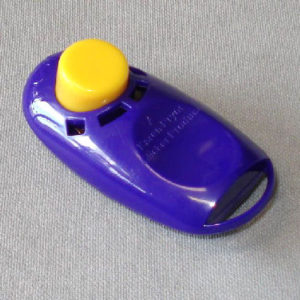
Many people question the use of a clicker in dog training. You don’t absolutely have to have one, or use one, but it’s a useful tool and we think everyone should try it.
In our social media groups about dog sports competition, there are people who are “never-clickers.” Their arguments are that:
- I don’t have enough hands
- It can’t be used in competition
- It’s one more thing I have to “fade” (stop using)
- I always have my voice with me
Those are valid points. And if you’re absolutely opposed to the idea, you can do without.
One the other hand, the clicker allows:
- Everyone training the dog to “sound” the same
- Is instantaneous to mark good stuff
- Lets you delay the treat
- Improves your timing
The clicker is particularly wonderful if you have a fast-learning, fast-moving dog who loves to do “stuff” with you. By the time you can say “good” or “yes,” Fido’s already doing something else, because your feedback wasn’t fast enough. Think it’s not true? We’ll loan you Hope’s Torque, or Fran’s Simon for a 2-Minute Session. Those boys are hard to keep up with, even with a clicker.
Just this week, Hope decided to add a “bow” to Torque’s repertoire. She thought about how to teach it, figuring to use a small box. She’d reward for putting his hind legs on the box the first session. Later 2-Minute Sessions would add lowering his front end while keeping his rear up in the air.
Torque already knows “back up,” so Hope put down the box and Torque was already moving, backing up onto the box. She clicked as soon as both back feet were on it, signalling immediately to Torque that he was right, right then. If she had waited at all, his front legs would have been on the box as well, and the criteria for the new trick would have been unclear.
When your dog is used to working with a clicker, it’s a clear and immediate signal to him (or her) that he’s a good boy. And he knows (or will soon learn) to repeat the behavior that got the click. And was followed, in short order, by treats!
Once our dogs learn to think, are rewarded for trying, and have fun spending time with you, it becomes easier and easier to develop new tricks, or behaviors. It’s fun and challenging for everyone – dogs and people!
